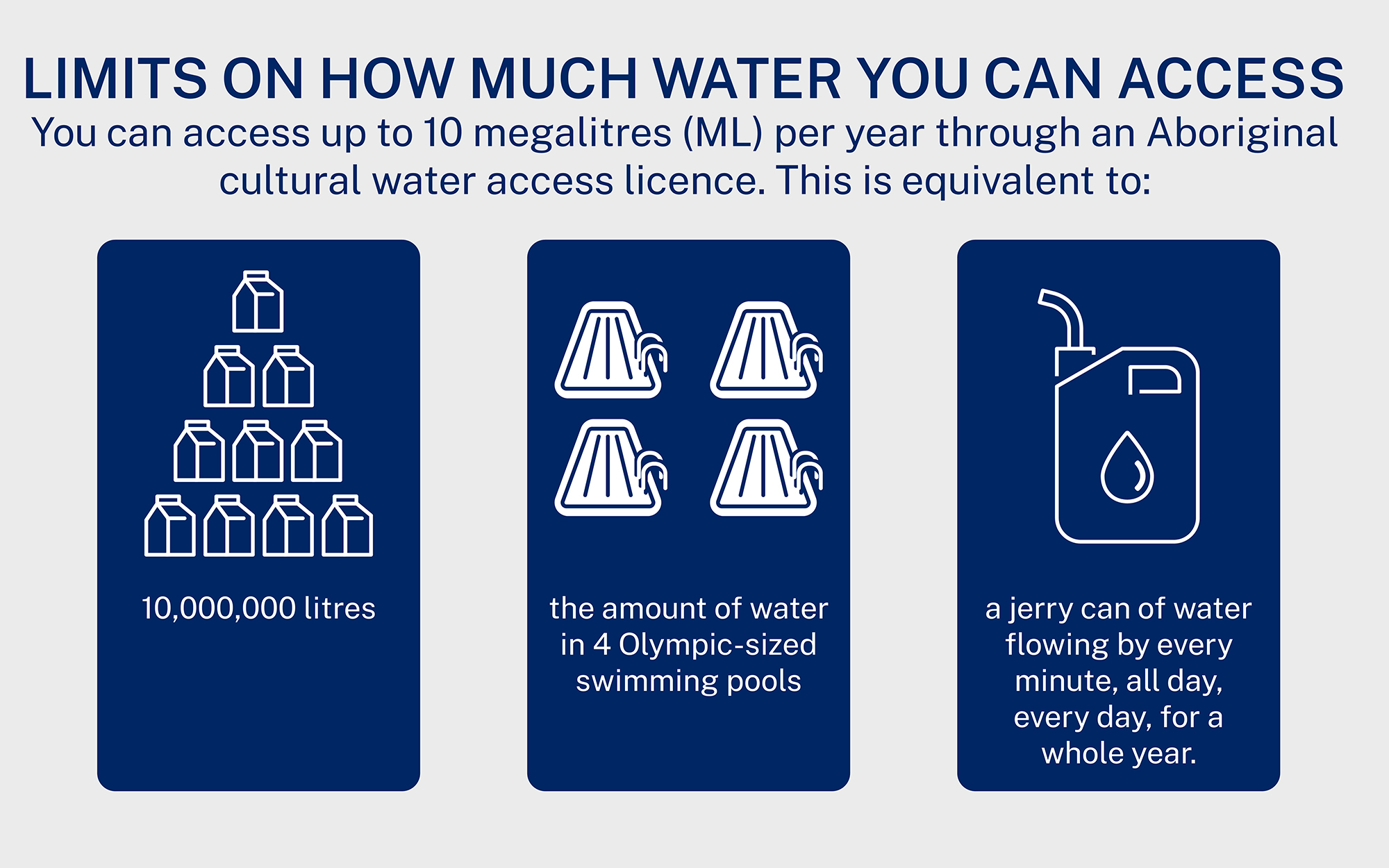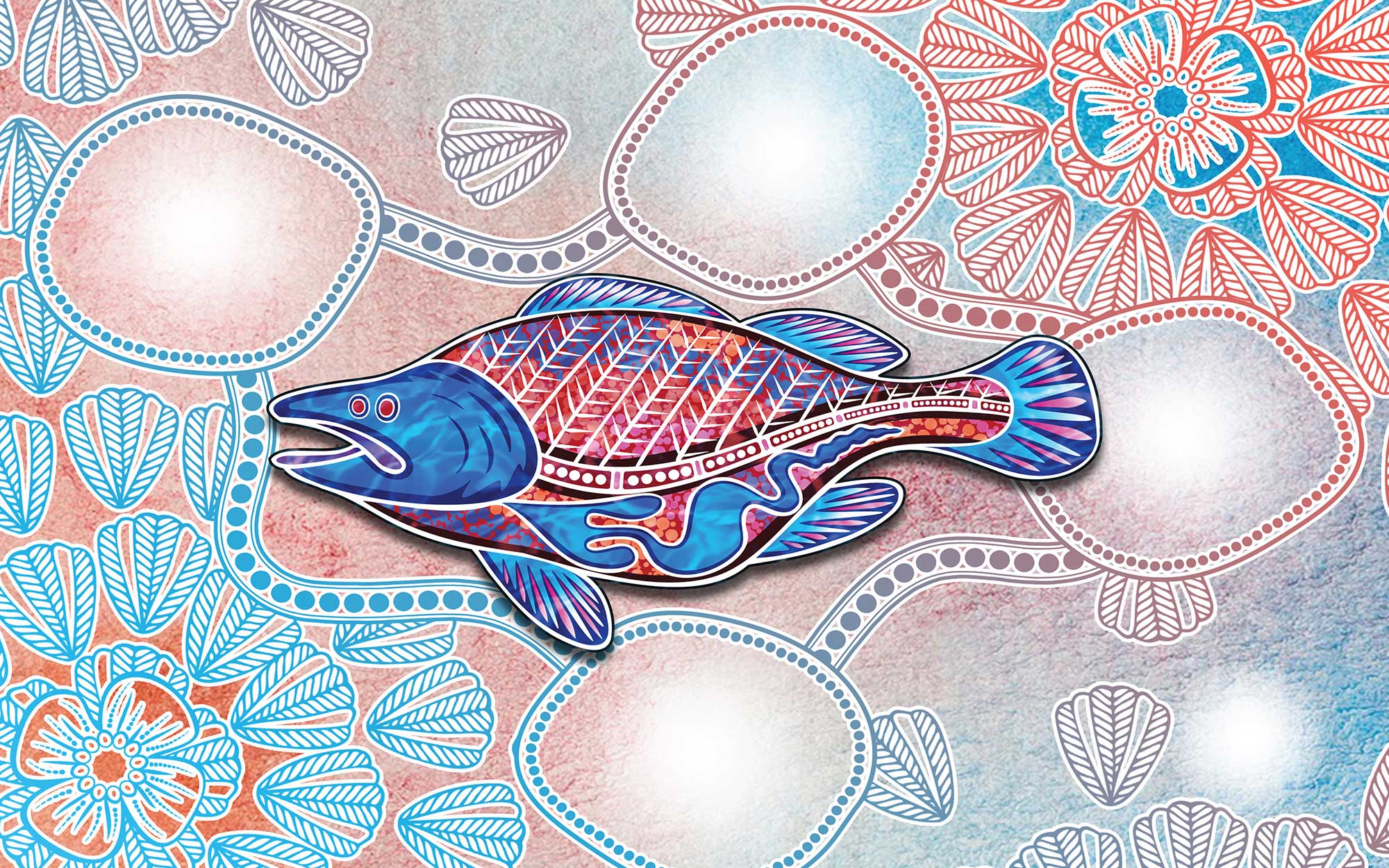Cultural water for the mob
"We need water for our cultural practices. We teach our kids all their skills on the river. If we don't have that, then our culture is gone".
- Veneta Duncan, CEO of the Nyngan Aboriginal Land Council, talking about the Bogan River to the ABC in 2019
Access to water empowers Aboriginal people’s connections to spirit, culture, the environment and to other people.
In NSW, Aboriginal people can access water to care for Country and mob, and to help maintain traditional cultural practices and customs by having an Aboriginal cultural specific purpose access licence.
You can use Aboriginal cultural water:
- in the stream or river
- in dams, billabongs, lagoons or wetlands (natural or artificial)
- by pumping water from a water source.
About Aboriginal cultural specific purpose access licences
Cultural water uses
Examples of how Aboriginal cultural water may be used:
- heal and restore Country
- tell stories and pass on culture to the next generation
- care for totems
- rehabilitate degraded wetlands and billabongs to attract diverse wildlife, including birds, fish, turtles and eels or alternatively to preserve thriving wetlands and billabongs.
- irrigate plants and nurseries to supply food and medicine to keep people safe, happy and healthy or to rehabilitate degraded country with native plants
- establish aquaculture where the primary purpose is to supply traditional foods such as yabbies, fish and other water animals to Aboriginal people for cultural purposes.
- allow children to enjoy playing and swimming in clean, safe and good quality water
- honour and protect law/lore, ceremonies and knowledge
- protect sacred sites and species.
There are also other reasons you can use cultural water. It is up to each community to determine its unique set of cultural values.
Who can apply for a licence
An Aboriginal person or an Aboriginal community organisation, such as an Aboriginal land council, can apply for an Aboriginal cultural water access licence.
Cost of a licence
Aboriginal cultural water licences are provided free of charge to eligible applicants until mid-2025.
Conditions on cultural water access licences
The key conditions of an Aboriginal cultural water access licence include:
- applicants need to be of Aboriginal descent
- the primary purpose of the licence is for cultural purposes, it cannot be to use the water for financial gain, such as growing crops or vegetables to sell at local markets
- the maximum amount of water you can get in one application is 10 ML. This is equivalent to:
- 10,000,000 litres per year
- the amount of water in 4 Olympic-sized swimming pools
- a jerry can of water flowing by every minute, all day, every day, for a whole year.

- the licence can be surrendered if it is no longer required or cancelled if the purpose for which it was issued no longer exists
- licence holders can’t sell or transfer the licence to another person or change it to someone else’s name.
All Aboriginal cultural water access licences are subject to conditions. For example, conditions on the licences in unregulated rivers state that water must stop being taken when the river drops to a specified level.
Apply for a licence
Aboriginal cultural water access licences are a type of water access licence with conditions or restrictions such as the location where it can be used.
Apply for an Aboriginal cultural water licence
FAQs
What water sources are included in the licence?
You can get an Aboriginal cultural water access licence for all water sources in NSW. This includes rivers, creeks, streams and lakes as well as groundwater (the water below the land surface).
Who assess the applications for a water access licence?
The department's Water Group reviews, assesses and issues Aboriginal cultural access licences and associated approvals.
What if I need more than 10 ML of water for cultural purposes?
Individuals and Aboriginal community organisations are encouraged to coordinate applications for Aboriginal cultural water access licence in their community to secure adequate cultural water access for the entire community. If there are multiple cultural purposes, then up to 10ML can be issued for each purpose.
Can more than one person apply for a licence at the same location or site?
Yes. Multiple Aboriginal people and/or organisations can apply for an Aboriginal cultural water access licence at the same location or cultural site.
Is there a limit to how many licences a person or organisation can hold?
No. An Aboriginal person or organisation can apply for several Aboriginal cultural water access licences. This can be at one location if each licence is for different cultural purposes and different sites or water sources.
On one property, you might have multiple distinct reasons, such as:
- one licence is used to stay in the river or stream for traditional fishing
- another licence is used to pump water from a stream onto land for a bush food nursery.
- another license is used to pump water from a bore onto land for the same bush food nursery
- another license is used to pump water onto land to keep a cultural wetland full
- another license is used to build a dam to be used for cultural purposes.
Each licence can be for up to 10 ML/year.
A single site may have access to multiple water sources*, such as:
- an alluvial or sand aquifer
- a fractured or porous rock aquifer
- a regulated river
- an unregulated river (in stream)
- an unregulated river (overland flow)
A licence of up to 10 ML/year can be applied for in each water source, regardless of the cultural purpose.
*Water sources:
- alluvial or sand aquifer has groundwater between grains of sand, gravels and other uncemented sediments
- fractured or porous rock aquifer has groundwater in pores and cracks in the rock
- regulated river contains water storages in dams and weirs. The river level and flow rate can be controlled or regulated by water being released from a storage.
- an unregulated river may have minor water storages (such as weirs) but its level and flow rate cannot be controlled by water being released. It also includes minor streams and overland flow that can be captured by farm dams.
Is there a limit to how many Aboriginal cultural water licences can be applied for in a water source?
There is no limit to how many Aboriginal cultural water access licences can be applied for in any water source.
However, there are measures in place to ensure enough water remains for critical needs to protect humans, animals and the environment.
This hierarchy of water allocations video explains the order of priorities.
What do I need to do to remove water from a water source?
If you plan to pump Aboriginal cultural water from a river, stream, lake or aquifer and use it on land, you need to consider 3 factors:
Permission from landowner: you need to have the landowner's permission to pump cultural water and use it on the land. They landowner could be an Aboriginal land council, the local Aboriginal community, a local council, the Indigenous Land and Sea Corporation, an Aboriginal Corporation or a private landowner who wants to support the local mob.
Water supply work approval: you need to apply for a water supply work approval to install the pump, drill the bore or build a dam (depending on the size and type of the dam). This can be applied for after the Aboriginal cultural water access licence is issued, and a dealing (or water trade) can then be done to link the approval to your licence. These work approval applications are also free for Aboriginal people and organisations.
Location and use of water: you need to confirm where you are going to pump the water to and how you will pump it. Explain details such as:
- if the water will fill a natural billabong, water hole, wetland or swamp that you use for cultural purposes
- if the water will fill a dam, tank or artificial wetland that has been built on the land from where you will then use it for cultural purposes
- if you need solar, electric or petrol pumps to get the water from one place to another.
What if I choose to keep cultural water in the water source?
If water from an Aboriginal cultural water licence is kept in a regulated river at a specific location, it could be used further downstream by other water users in another water source.
Protecting information about the use of cultural water for a sacred site
The department’s Indigenous Cultural and Intellectual Property Protocol has been implemented to protect the rights that Aboriginal people have to their cultural heritage. This includes protecting traditional knowledge and sacred sites.
A detailed location may not be required for the Aboriginal cultural water access licence application, particularly if the Aboriginal cultural water is proposed to stay in the river, stream, lake, billabong, water hole, wetland, aquifer or swamp.
More information:
Find more information here:
Artist acknowledgement: Nathan Peckham
As a proud Tubba-gah man from Dubbo in the Wiradjuri Nation, I respectfully acknowledge all nations which the NSW DPE operates on. I acknowledge this artwork will be viewed off my home country of the Tubba-gah people and therefore ask you accept this artwork as an offering on behalf of my family as a gesture of continuing the legacy of the knowledge of our ancestors.
I would also like to pay respect to all traditional custodians of the country whose ancestral lands we all walk upon. I thank the Elders for their wisdom, courage, and sacrifice and pledge my commitment to preserving their legacy for future generations.
- Nathan Peckham
